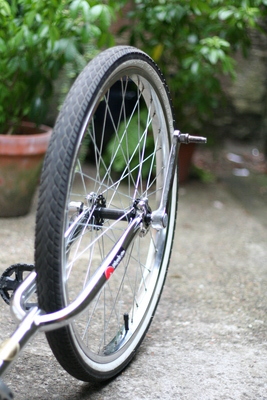
Oops, I broke the unicycle. A bit too much hopping and rough ground for this poor “beginner” unicycle. The pedal axle snapped in half. It left me, as the guy in the Bike Chain pointed out, with a uni-pedal uni-cycle. I’ve repaired it now, but it’s a sign that this is not the unicycle for learning trials-style tricks on.
Today, in addition to my usual circuits, I was practising doing “stops” – riding along, briefly stopping, then riding on. You lean backward slightly whilst riding, then stop the pedals. The wheel stops, but you keep going, resulting in the perfect forward tilt to resume riding. I also practised riding slowly, which is another good way to practise balance.
Update: Managed a few more moves: seat-out jump mount and 180 degree spin/jumps are nailed. I managed a little bit of seat-out riding, and tried (but failed) a 180 jump mount. The jump/spins are very practical – no need to do a tricky balanced turn when you can just hop round in one go. 🙂 I also have clearly forgotten this morning’s lesson on the tensile strength of pedal axles, because I’m still doing hops on this unicycle. Time to go shopping…